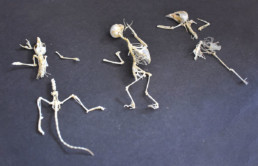
ACQUIRE
Keep gloves, a knife, and plastic bags in a pack when traveling or hiking
1) Bag and label the specimen with a date, place, possible cause of death and type of animal.
2) Freeze for at least 72 hours to kill parasites and allow time to plan and prepare. You can keep them frozen indefinitely without damage.
3) Be aware that some creatures are not legal for personal possession. States have different restrictions.
4) Enjoy the process of your creative scavenging.

PREPARE
Spend time thinking about your final piece before starting
1) Create a sketch of how you want the final piece to look.
2) Will it be a preservation of the bones, hide or even both?
3) Most pieces would benefit from a support base to keep it sturdy and easier to transport.
4) Traditional taxidermy will require a form. Smaller creatures can use cotton and string. If it is larger than a cat, consider using a pre-made foam form: Purchase Forms here
5) Will you want to purchase/create props, eyes and clothing?
6) Do you plan to ship it in the mail as a gift or keep it at home?

CREATE
Allow yourself a full afternoon for your first creation
1) Acquire needed materials and tools.
2) Create a workspace (scented candles or incense can be helpful).
3) Thaw for 2+ hours depending on size.
4) Consider documenting your experience via video, time-lapse, audio, or photography.

AFTERCARE
Care for your creation so it lasts forever
• Cedar wood and cedar oils will help deter moths.
• Give your piece a light spray of Lysol (anti-bacterial) every few days to keep any little bugs away as they fully cure. Then, just a few times a year.
• Be gentle with the fur. Specimens that are found outside are prone to “hair slippage”. This happens when bacteria gets into the animal and will cause the hair to simply fall off. Try to find a fresh animal that hasn’t bloated or contracted flies. You can certainly do patching and reinforcement to fix a great deal of it.